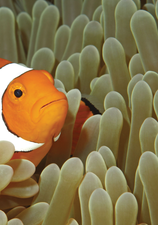Visual programming with Alice
Finding Nemo

If you can use your desktop environment, then you can also write programs: All you need is your mouse, the Alice IDE, and some time to experiment.
In the Alice development environment, you don't need to type in a single command or learn a cryptic language. Instead, you can create applications and compile all the necessary actions and processes just by clicking your mouse. You start by dragging ready-made items into an empty 3D world. Each item offers several actions that change its appearance, its location, or its behavior. Then, you can just drag and drop the desired actions into a sequence plan, which Alice executes on demand.
Easy-as-pie controls certainly have their limits. For example, the applications created here are always rooted in the 3D world. Alice is therefore suitable mainly for 3D animations or games. The almost mandatory requirement for the 3D world is that Linux supports your video card's 3D acceleration; otherwise, the program you create will run at a snail's pace.
Number Girl
Alice [1] currently exists in two versions. According to the makers, children especially should use the older version 2. Above all, this version teaches logical thinking and the basics of programming. The new version 3, however, focuses on object-oriented programming. It increasingly uses the standard terminology found in this field, thus allowing an easier transition to Java later on.
[...]
Buy this article as PDF
(incl. VAT)
Buy Linux Magazine
Subscribe to our Linux Newsletters
Find Linux and Open Source Jobs
Subscribe to our ADMIN Newsletters
Support Our Work
Linux Magazine content is made possible with support from readers like you. Please consider contributing when you’ve found an article to be beneficial.

News
-
Linux Kernel 6.16 Reaches EOL
Linux kernel 6.16 has reached its end of life, which means you'll need to upgrade to the next stable release, Linux kernel 6.17.
-
Amazon Ditches Android for a Linux-Based OS
Amazon has migrated from Android to the Linux-based Vega OS for its Fire TV.
-
Cairo Dock 3.6 Now Available for More Compositors
If you're a fan of third-party desktop docks, then the latest release of Cairo Dock with Wayland support is for you.
-
System76 Unleashes Pop!_OS 24.04 Beta
System76's first beta of Pop!_OS 24.04 is an impressive feat.
-
Linux Kernel 6.17 is Available
Linus Torvalds has announced that the latest kernel has been released with plenty of core improvements and even more hardware support.
-
Kali Linux 2025.3 Released with New Hacking Tools
If you're a Kali Linux fan, you'll be glad to know that the third release of this famous pen-testing distribution is now available with updates for key components.
-
Zorin OS 18 Beta Available for Testing
The latest release from the team behind Zorin OS is ready for public testing, and it includes plenty of improvements to make it more powerful, user-friendly, and productive.
-
Fedora Linux 43 Beta Now Available for Testing
Fedora Linux 43 Beta ships with Gnome 49 and KDE Plasma 6.4 (and other goodies).
-
USB4 Maintainer Leaves Intel
Michael Jamet, one of the primary maintainers of USB4 and Thunderbolt drivers, has left Intel, leaving a gaping hole for the Linux community to deal with.
-
Budgie 10.9.3 Now Available
The latest version of this elegant and configurable Linux desktop aligns with changes in Gnome 49.

